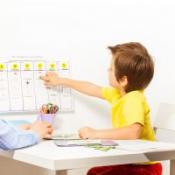 Most articles you read about helping children and teens with attention-deficit hyperactivity (ADHD) complete homework are likely to focus on having a structured plan. A structured plan—do homework in the same location, take breaks at specific times, etc.—can indeed be helpful, but often parents underestimate the importance of the actual environment in which the homework is done.
Most articles you read about helping children and teens with attention-deficit hyperactivity (ADHD) complete homework are likely to focus on having a structured plan. A structured plan—do homework in the same location, take breaks at specific times, etc.—can indeed be helpful, but often parents underestimate the importance of the actual environment in which the homework is done.
Here are five suggestions to help develop the ideal work environment for your child or teen:
- Make sure the work area is physically comfortable. This means having your child or teen sit in a comfortable chair. Ideally, they should be sitting at a desk or using a lap desk (as opposed to sitting on the floor or bed), but see what works best for them. Using a chair that reclines slightly or is padded may make it easier to sit and focus for longer periods.
- If your child or teen fidgets, harness the fidgeting. If they fidget with their legs, for example, provide your child or teen with something to keep their legs occupied. Try a bicycle or elliptical base that fits under a desk; exercise bands attached to the chair; tennis balls cut open and glued to the floor; or large, squishy shoe innersoles attached to the floor. For individuals who fidget with their hands, try something such as attaching a stress ball to a stretchy string that’s connected to the desk. Alternatively, attach something with different textures to the desk so your child or teen can rub their hand against something while working.
- Minimize shifting of attention. This can be achieved by decreasing the frequency with which your child or teen needs to switch between their book and the computer, documents on the computer, getting up to get materials, and so forth. To decrease shifting between materials, many individuals (adults included) do well with using a laptop and attaching an external monitor (or LCD television) to it. With two screens, they can keep documents they are referring to on one screen and write on the other. Using a laptop and a tablet for this purpose can also work well, especially if the tablet has a stand. To help with textbooks, using a kitchen book holder that props up the book and keeps it open to set pages can be useful. To avoid children and teens having to get up frequently, keep a few pens, pencils, highlighters, and basic school supplies within arm’s reach.
- Reduce visual and auditory distractions. Keep the walls within view fairly plain if possible, and if looking out a window is distracting, face the workspace away from the window. Auditory distractions can be minimized by being quiet around your child or teen, using a white noise machine, or using an app (with or without headphones). Some children and teens like noise while working. If they feel they need to listen to something while working, white noise or music without words might be best. While ideally music should be soft, if your child or teen insists on listening to popular music while working, have them listen to karaoke versions.
- Have different work stations for different types of tasks. Some teens may find it helpful to sit in a special chair just for reading, to use a desk for writing papers, and to use a reclining chair for proofreading. Sometimes a change in position or room between tasks can lead to increased focus and reduce fatigue. (For others, of course, it can lead to getting off task more easily.)
There are many things you can do to help your child or teen get their homework done. While a structured plan is key, so too is the setup of the actual workspace. Try the tips above to get the most out of your child’s study time.

The preceding article was solely written by the author named above. Any views and opinions expressed are not necessarily shared by GoodTherapy.org. Questions or concerns about the preceding article can be directed to the author or posted as a comment below.

 How to Help Children and Teens with ADHD Stay on Task
How to Help Children and Teens with ADHD Stay on Task Admonishing Children with ADHD: Get the Results You Want
Admonishing Children with ADHD: Get the Results You Want Back-to-School Tips for Children and Teens with ADHD
Back-to-School Tips for Children and Teens with ADHD

Please fill out all required fields to submit your message.
Invalid Email Address.
Please confirm that you are human.
Leave a Comment
By commenting you acknowledge acceptance of GoodTherapy.org's Terms and Conditions of Use.